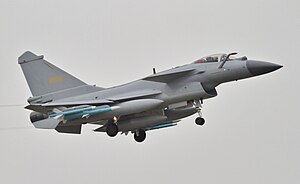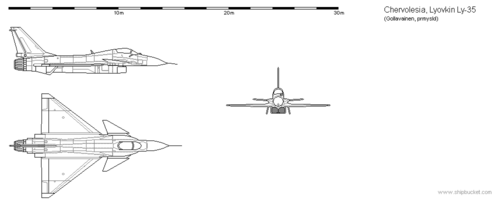SAI Baregheh
| Mykajlov-Lutsenko MyL-34 | |
|---|---|

| |
| Role | Multirole fighter |
| National origin | Chervolesia |
| Designer | Mykajlov-Lutsenko Design Bureau |
| First flight | 1991 |
| Introduction | 1993 |
| Status | In service |
| Primary user | People's Liberation Army Air Force People's Liberation Army Navy |
| Produced | 1993-Present |
| Number built | 895 |
The Mykajlov-Lutsenko MyL-34 (Narodyn: Микайлов-Лутсенко МиЛ-34; AFDC reporting name: Phantom) is a single-seat, all-weather third-generation jet fighter developed by Mykajlov-Lutsenko Design Bureau and manufactured by the Aleksandrovka Aerospace Syndicate for the People's Liberation Army Air Force.
Design and development
Origins
During the 1980s, the People's Liberation Army Air Force (PLAAF) fighter command conducted several studies evaluating the future of air combat and air forces. The studies showed both the faults of the current PLAAF structure, in regards to mobilization and maintenance needs, and in domestic production capacity. The results of the studies emphasized that future PLAAF aircraft should be multipurpose planes, able to take on fighter-interceptor, ground attack, and reconnaissance roles; and that all fighter squadrons should be composed solely of these new multirole fighters. Aleksandrovka Aerospace Syndicate (AAS) was already producing the latest model of the MyL-20, which were nearing the end of their operational lifespan, but a lack of alternatives meant that production lines would remain in place until a new fighter model was chosen by the PLAAF. In order to save costs, the Stavka of the People's Liberation Army (PLA) dictated that any future PLAAF fighter would have to be shared between both the People's Liberation Army Navy (PLAN) and PLAAF.
With this new directive in mind, the PLAAF and PLAN issued a joint-request for a new multirole fighter to replace the aging MyL-20s in PLAAF service and MyL-22K in PLAN service. The joint-acquisition board tasked the Lyovkin Design Bureau with designing the new fighter, and awarded the production contract to AAS. The original criteria for the new multirole fighter design were set as: high operational capacity for all combat missions, affordable production cost, and high tactical capability. Shortly after this criteria was submitted to Mykajlov-Lutsenko OKB, additional criteria was sent to include: outperforming the MyL-22K by at least 50%, and surpassing the Nuxican F-16 and Gaullican Mirage 2000 in all forms of combat.
Design and testing
Faced with almost contradictory requirements, the Mykajlov-Lutsenko design team ultimately decided to focus on the prerequisite requirements issued by the joint-acquisition board: high operational capacity, affordable cost, and high tactical capability. Additionally, the team opted to include the outperforming the Ly-21K by 50%. The design team began work in 1987 and gravitated towards a single-engine canard-delta design, as seen on the Gaullican Mirage 2000. The design's true strength came from a unified and digitally computerized electronics suite for both air-to-ground and air-to-air missions, built around a new multipurpose radar.
Unlike the previous Ilchenko Il-31, the newest adopted fighter at the time of the MyL-34's conception, the Mykajlov-Lutsenko design team ultimately chose a single-engine design. Concerns about single-engine designs had all but disappeared as Chervolesian aircraft engine capabilities matured due to a combination of production and design experience, and technological assistance from Swetania. A new model of the Almaida AM-42 turbofan was selected to power the aircraft. The new engine design, the AM-42M, was able to generate 7% more force, incorporate infrared and optical signature visibility reduction systems, and has an increased service life of 4,000 hours. This engine was chosen as a compromise between the PLAAF and PLAN, the latter of which required a stronger engine for carrier take-off and landing operations.
Work on the new radar faced initial delays as the PLAAF and PLAN could not agree on a joint set of criteria. The Osa-F was initially chosen for the design due to the increased capabilities the F model had over the base Osa. However, poor weight distribution during initial test flights forced the design team to reassess domestically available radar systems. A lighter, albeit less capable, version of the Osa radar was chosen, dubbed the Šeršen, was chosen in 1992 as a stopgap as a lightweight version of the much more capable Osa-F was being developed. This version of the Osa-F would not be introduced until the introduction of the Ly-35M in 2015.
Test flights of the Mykajlov design, designation as Izd. 85 (Mykajlov-Lutsenko Experimental Product 85 - 85 referring to RY85 when the aircraft was expected to enter service), began in June, 1991. Initial flights were done without the radar, and instead a concrete counterweight was placed in the radome. Two aircraft were lost due to pilot error, resulting in the death of one test pilot and the loss of both airframes. The first test flight with the Osa-F was conducted on 18 September, 1991. Testing with the lightweight Šeršen radar suite was conducted from April, 1992 until February 1993.
Production
The MyL-34's final prototype was ordered into full scale production on 26 February, 1993, a full three years before the plane's expected adoption. An initial order of 200 airframes were made to first replace MyL-22K squadrons serving on the Volosovo. The first naval squadron would be stationed to the Volosovo in March, 1993, while the first operational PLAAF squadron would not see service until July, 1993.
Design
Armament
Powerplant
Variants
Carrier-based
Land-based
Operational history
Current Chervolesian inventory
Operators
Specifications (MyL-34M)
General characteristics
- Crew: 1
- Length: 14.4 m (47.2 ft)
- Wingspan: 9.46 m (31.0 ft)
- Height: 4.35 m (14.3 ft)
- Empty weight: 7,750 kg (17,085 lb)
- Loaded weight: 11,490 kg (25,331 lb)
- Max. takeoff weight: 13,000 kg (28,660 lb)
- Powerplant: 1 × Almaida AM-42 afterburning turbofan
- Dry thrust: 50 kN (11,240 lbf)
- Thrust with afterburner: 81 kN (18,210 lbf)
Performance
- Maximum speed: Mach 1.8 (2,222 km/h; 1,381 mph)
- Combat radius: 2,000 km (1,240 miles) on internal fuel
Armament
- Guns: 1× MTs-30 autocannon, 130 rounds
- Hardpoints: 9 hardpoints with a capacity of 3,500 kg and provisions to carry combinations of:
- Rockets:
- Missiles:
- Bombs:
- Other:
- Drop tanks:
- Drop tank with 650 kg fuel (centerline)
- Drop tanks:
- Rockets:
Avionics
Osa-F PESA radar
OLS-UEM electro-optical targeting system
